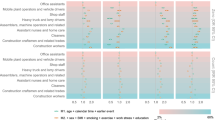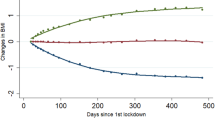Abstract
OBJECTIVES: In many studies, obesity has been associated with morbidity or mortality, but only a few have studied the relation between obesity and sick leave. Our aim is to analyse the independent effects of both adiposity and body fat distribution in relation to the 1-y incidence of sick leave in a large cohort of male and female workers covering a variety of occupations, taking into account a wide range of socio-demographic, behavioural and bioclinical variables.
DESIGN AND SETTING: The baseline survey of the Belstress study was conducted in 25 companies across Belgium between 1994 and 1998. A cohort of 20 463 workers (15 557 males and 4906 females) aged 35–59 y was followed for absenteeism during 1 y. The 75th percentile of the distribution of the total annual sickness days was used as a cutoff to classify the workers with a high 1-y incidence rate of sick leave. The relation between sick leave and both obesity and body fat distribution assessed by the body mass index (BMI) and the waist circumference, respectively, was analysed by multivariate logistic regression models.
RESULTS: Using a backward procedure based on the likelihood ratio, we found central abdominal fatness to be an independent predictor of sick leave in both genders (high sick-leave incidence and long spells), but not BMI. In men, the odds ratios was 1.31 (99% CI 1.12–1.52, P<0.0001) and in women it ranged from 1.32 (99% CI 1.03–1.70, P=0.005) to 1.47 (99% CI 1.14–1.90, P<0.0001). Two baseline covariables, respiratory problems and perceived health, are confounders or mediators.
CONCLUSIONS: In this study, body fat distribution was associated with a high annual sick-leave incidence and long spells of sickness absence. If this link is reversible, employers may benefit from programs aiming at the prevention and treatment of central obesity.
This is a preview of subscription content, access via your institution
Access options
Subscribe to this journal
Receive 12 print issues and online access
$259.00 per year
only $21.58 per issue
Buy this article
- Purchase on Springer Link
- Instant access to full article PDF
Prices may be subject to local taxes which are calculated during checkout







Similar content being viewed by others
References
Larsson B . Regional obesity as a health hazard in men—prospective studies. Acta Med Scand Suppl 1988; 723: 45–51.
Higgins M, Kannel W, Garrison R, Pinsky J, Stokes J . Hazards of obesity—the Framingham experience. Acta Med Scand Suppl 1988; 723: 23–36.
Lean M, Han T, Seidell J . Impairment of health and quality of life in people with large waist circumference. Lancet 1998; 351: 853–856.
Bjorntorp P . The associations between obesity, adipose tissue distribution and disease. Acta Med Scand Suppl 1988; 723: 121–134.
Nieman D, Henson D, Nehlsen-Cannarella SL, Ekkens M, Utter AC, Butterworth DE, Fagoaga O . Influence of obesity on immune function. J Am Diet Assoc 1999; 99: 294–299.
Sjostrom L . Mortality of severely obese subjects. Am J Clin Nutr 1992; 55: 516S–523S.
Vague J . La differentiation sexuelle. Facteur déterminant les formes de l'obésité.(Sexual differentiation. Factor determining obesity types). Presse Méd 1947; 55: 339–341.
Larsson B, Svardsudd K, Welin L, Wilhelmsen L, Bjorntorp P, Tibblin G . Abdominal adipose tissue distribution, obesity, and risk of cardiovascular disease and death: 13 year follow up of participants in the study of men born in 1913. Br Med J (Clin Res Ed) 1984; 288: 1401–1404.
Bjorntorp P . The android woman—a risky condition. J Intern Med 1996; 239: 105–110.
Marin P, Bjorntorp P . Endocrine-metabolic pattern and adipose tissue distribution. Horm Res 1993; 39 (Suppl 3): 81–85.
Elmslie J, Silverstone J, Mann J, Williams S, Romans S . Prevalence of overweight and obesity in bipolar patients. J Clin Psychiatry 2000; 61: 179–184.
Rosmond R, Eriksson E, Bjorntorp P . Personality disorders in relation to anthropometric, endocrine and metabolic factors. J Endocrinol Invest 1999; 22: 279–288.
Epel ES, McEwen B, Seeman T, Matthews K, Castellazzo G, Brownell KD, Bell J, Ickovics J . Stress and body shape: stress-induced cortisol secretion is consistently greater among women with central fat. Psychosom Med 2000; 62: 623–632.
Bjorntorp P . Stress and cardiovascular disease. Acta Physiol Scand Suppl 1997; 640: 144–148.
Bjorntorp P . Heart and soul: stress and the metabolic syndrome. Scand Cardiovasc J 2001; 35: 172–177.
Han T, Tijhuis M, Lean M, Seidell J . Quality of life in relation to overweight and body fat distribution. Am J Public Health 1998; 88: 1814–1820.
Narbro K, Jonsson E, Larsson B, Waaler H, Wedel H, Sjostrom L . Economic consequences of sick-leave and early retirement in obese Swedish women. Int J Obes Relat Metab Disord 1996; 20: 895–903.
Moens G, Van Gaal L, Muls E, Viaene B, Jacques P . Body mass index and health among the working population. Epidemiological data from Belgium. Eur J Public Health 1999; 9: 119–123.
Tucker L, Friedman G . Obesity and absenteeism: an epidemiologic study of 10,825 employed adults. Am J Health Promot 1998; 12: 202–207.
Grunstein R, Stenlof K, Hedner J, Sjostrom L . Impact of self-reported sleep-breathing disturbances on psychosocial performance in the Swedish Obese Subjects (SOS) Study. FAU—Grunstein, R R FAU—Stenlof, K FAU—Hedner, J A FAU—Sjostrom, L. Sleep 1995; 18: 635–643.
Coetsier P, De Backer G, De Corte W et al. Etude belge du stress au travail: aperçu du modèle de recherche et des outils d'investigation. (Belgian study of work stress: outline of research model and research tools). Psychol Psychométrie 1996; 17: 17–35.
Pelfrene E, Vlerick P, Kittel F, Mak R, De Backer G, Kornitzer M . Psychosocial work environment and psychological well-being: assessment of the buffering effects in the job demand-control(-support) model in Belstress. Stress Health 2002; 18: 43–56.
International Standard Classification of Occupations. ISCO-88 Geneva; 1990.
Liberatos P, Link B, Kelsey J . The measurement of social class in epidemiology. Epidemiol Rev 1988; 10: 87–121.
Rose G, Blackburn H, Gillum R, Prineas R . Cardiovascular Survey Methods. World Health Organisation: Geneva; 1982.
Dirken JM . Arbeid and gezondheid. Work and Health. Wolters-Noordhoff: Groningen; 1969.
Monica Manual. World Health Organisation: Geneva; 1990.
De Backer G, Kornitzer M, Dramaix M, Kiltel F, Thilly C, Graffar M, Vuylsteek K . The Belgian Heart Disease Prevention Project: 10-year mortality follow-up. Eur Heart J 1988; 9: 238–242.
Jones Deborah. The MONICA Optional Study of Physical Activity (revised manual of operations) 1994.
Karasek R, Baker D, Marxer F, Ahlbom A, Theorell T . Job decision latitude, job demands, and cardiovascular disease: a prospective study of Swedish men. Am J Public Health 1981; 71: 694–705.
Pelfrene E, Vlerick P, Mak R, De smet P, Kornitzer M, De Backer G . Scale reliability and validity of the Karasek ‘Job Demand–Control–Support’ model in the Belstress study. Work Stress 2001; 15: 297–313.
Karasek R . Job Content Questionnaire. Department of Industrial and Systems Engineering, University of California: Los Angeles; 1985.
Radlof L . The CES-D scale: a self-report depression scale for research in the general population. Appl Psychol Meas 1977; 1: 385–401.
Kohout F, Berkman L, Evans D, Cornoni-Huntley J . Two shorter forms of the CES-D depression symptoms index. J Aging Health 1993; 5: 179–193.
Carpenter J, Andrykowski M, Wilson J, Hall LA, Rayens MK, Sachs B, Cunningham LL . Psychometrics for two short forms of the Center for Epidemiologic Studies-Depression Scale. Issues Ment Health Nurs 1998; 19: 481–494.
Preville M, Boyer R, Potvin L, Perrault C, Légaré G . La détresse psychologique : détermination de la fiabilité et de la fiabilité de la mesure utilisée dans l'enquête Santé Québec. (Psychological distress: reliability determination and reliability of the measure used in the Quebec health survey). Cahiers de recherche no 7 Québec Gouvernement du Québec, Ministère de la santé et des services sociaux, Direction des communications 1992.
Ilfeld F . Further validation of a psychiatric Symptom Index in a Normal population. Psychol Rep 1976; 39: 1215–1228.
Berkman L, Syme S . Social networks, host resistance, and mortality: a nine-year follow-up study of Alameda County residents. Am J Epidemiol 1979; 109: 186–204.
Amirkhan JK . A factor analytical derived measure of coping: the coping strategy indicator. J Personality Social Psychol 1990; 5: 1066–1074.
Coetsier P, De Backer G, De Corte W, Hellemans C, Karnas G, Karuitzer M, Pelfrine E, Vlinick P . Onderzoeksdesign en instrumentarium van het belgish jobstress onderzoek—Modele de recherche et manuel de travail de l'étude Belge du stress au travail (Research model and work manual of the Belgian study of work stress). Theor toegepaste Psychol 1996. no 6.
Lean M, Han T, Morrison C . Waist circumference as a measure for indicating need for weight management. BMJ 1995; 311: 158–161.
The ‘Minnesota Code’ for ECG classification. Adaptation to CR leads and modification of the code for ECGs recorded during and after exercise by the Scandinavian Committee on ECG Classification. Acta Med Scand Suppl 1967; 481: 1–26.
Marmot M, Feeney A, Shipley M, North F, Syme S . Sickness absence as a measure of health status and functioning: from the UK Whitehall II study. J Epidemiol Community Health 1995; 49: 124–130.
North F, Syme S, Feeney A, Shipley M, Marmot M . Psychosocial work environment and sickness absence among British civil servants: the Whitehall II study. Am J Public Health 1996; 86: 332–340.
Hosmer D, Lemeshow S . Applied Logistic Regression. John Wiley & Sons: New York, Chichester, Brisbane, Toronto, Singapore; 1989.
Larsson B, Seidell J, Svardsudd K, Welin L, Tibblin G, Wilhelmsen L, Bjarntorp P . Obesity, adipose tissue distribution and health in men—the study of men born in 1913. Appetite 1989; 13: 37–44.
Larsson B, Bengtsson C, Bjorntorp P, Lapidus L, Sjöström L, Svärdsudd K, Tibblin G, Wedel H, Welin L, Wilhelmsen L . Is abdominal body fat distribution a major explanation for the sex difference in the incidence of myocardial infarction? The study of men born in 1913 and the study of women, Goteborg, Sweden. Am J Epidemiol 1992; 135: 266–273.
Narbro K, Agren G, Jonsson E, Lansson B, Näslund I, Wedel H, Sjöström L . Sick leave and disability pension before and after treatment for obesity: a report from the Swedish Obese Subjects (SOS) study. Int J Obes Relat Metab Disord 1999; 23: 619–624.
Author information
Authors and Affiliations
Corresponding author
Additional information
Study realised with grants from the National Foundation of Scientific Research (FNRS/FWO-Vlanderen) and the ‘Belgian Federal Office for Scientific, Technical and cultural Affairs' (SSTC)
Rights and permissions
About this article
Cite this article
Moreau, M., Valente, F., Mak, R. et al. Obesity, body fat distribution and incidence of sick leave in the Belgian workforce: the Belstress study. Int J Obes 28, 574–582 (2004). https://doi.org/10.1038/sj.ijo.0802600
Received:
Revised:
Accepted:
Published:
Issue Date:
DOI: https://doi.org/10.1038/sj.ijo.0802600
Keywords
This article is cited by
-
Use of various obesity measurement and classification methods in occupational safety and health research: a systematic review of the literature
BMC Obesity (2018)
-
Is central obesity associated with poorer health and health-related quality of life in primary school children? Cross-sectional results from the Baden-Württemberg Study
BMC Public Health (2013)
-
Cut off values of waist circumference & associated cardiovascular risk in egyptians
BMC Cardiovascular Disorders (2011)
-
The relationship between overweight and obesity, and sick leave: a systematic review
International Journal of Obesity (2009)
-
Body Mass Index and Employment-Based Health Insurance
BMC Health Services Research (2008)



